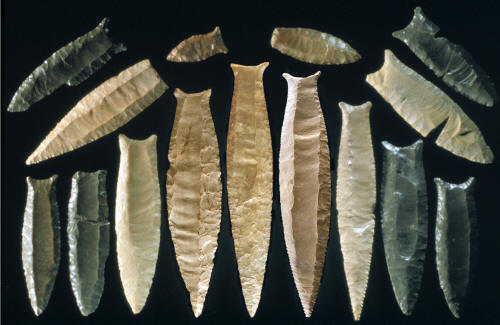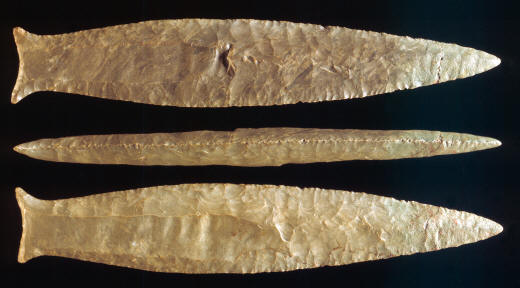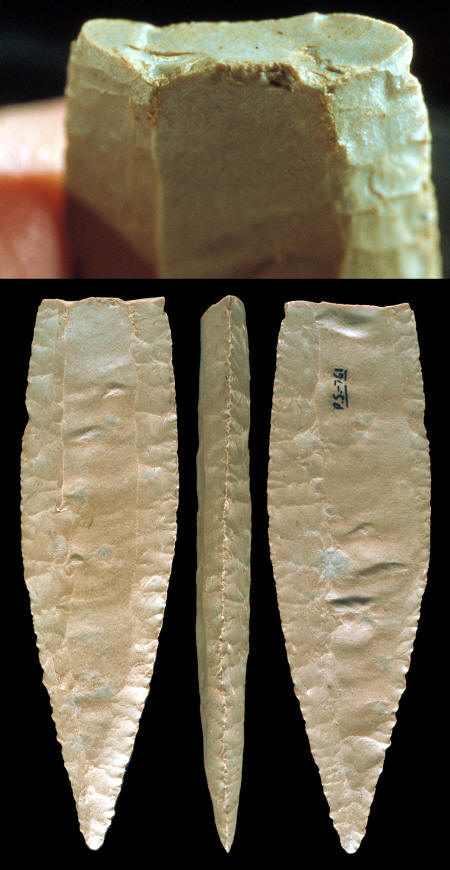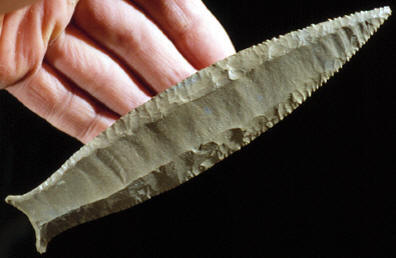|
|
|
Cumberland points are described as medium to large lanceolate points that are thick with recurved blade edges and expanding bases. They have concave bases with basal corners that are "eared" and stem edges that are ground. The flutes often extend the full length of one side of the point. Some rare examples are not fluted at all. Cumberland points are considered to be spear points that were probably propelled through the air with an atlatl. |
|
|
Cumberland points are exceptionally thick. In fact, they stand out from all other fluted points as the thickest. These lanceolate shaped points are sometimes compared to Folsom points because of their long flutes. But in size and thickness it's remarkable how different they are even though both were used to hunt very large animals. |
|
|
Cumberland points are most impressive and famous for their long flutes. A good number of them are fluted more than half the length of the point. Many of them are fluted the full length of the point. Of all the different types of fluted points found in North, South and Central America, Cumberland points have, on the average, much longer flutes than any other type. Perino writes that, "In order to strike off the long, narrow, fluting flakes, the point was made thick, narrow and diamond-shaped in cross-section. This created a median ridge necessary to carry the lengthy flute to completion." |
|
|
Modern flintknappers have used all kinds of techniques to flute Cumberland points. "Swoose's" technique is one of the more interesting. He squeezes the point in between a forked limb, putting pressure against the point and a platform on the base. He then taps the flat surface of the base near the platform until the flute detaches. |
|
|
The best examples of Cumberland points are very impressive for the craftsman's skill and technology that was used to make them. Only a very few modern day flintknappers can made a good Cumberland point. Dan Theus is one example. Cumberland people used core and blade technology to make a wide variety of different types of tools, like scrapers, gravers and perforators. One of the Cumberland points in this article was actually made on a blade, just as a large Clovis point from the Anzick Clovis cache was also made on a blade. Core and blade technology became well established in Europe during the Aurignacian period between 34,000 and 29,000 years ago. |
|
|
|
|
Some of the mysteries that have surrounded Cumberland points for so long are now only recently beginning to be understood. Their tool kit is seen for the first time from excavations of the Phil Stratton site. Also, what may have been a cultural tradition, a cache of Cumberland points were recently discovered for the first time on the Trinity site. It's obvious that Cumberland people liked to use large points to tip their spears and they used blade technology. A Cumberland knapper would have impressed any of the Old World Aurignacian flintknappers. The ability to demonstrate the manufacture of a long fluted Cumberland point is an illustration of Core and blade technology at it's best. |
|
|
"REFERENCES"
1958, Love, C. T.,
Central States Archaeological Journal, "Cumberland Fluted Spearhead,
Figure 75," p. 136. |
|





